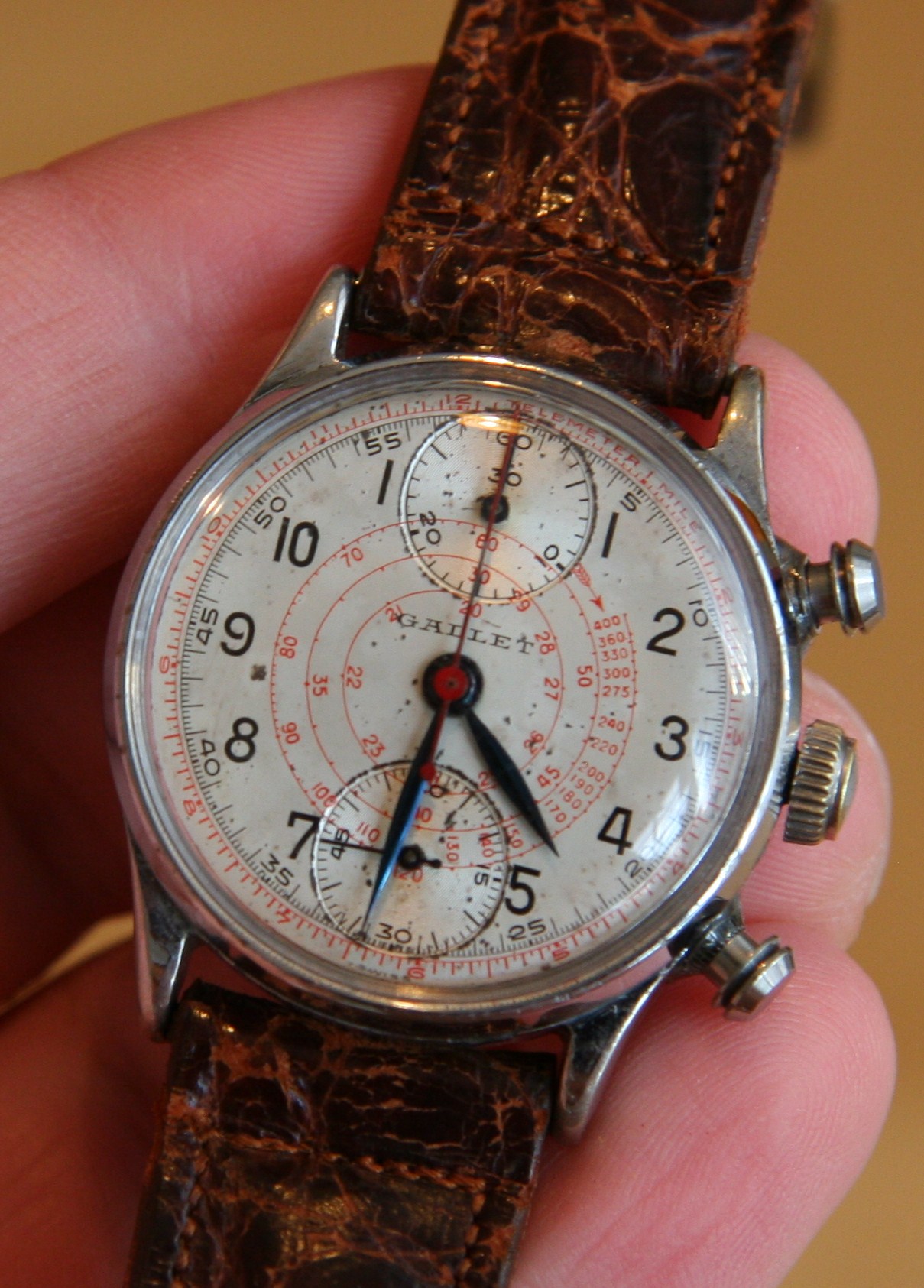
I am not really one of those “vintage guys.” You know the type; they like to buy things at thrift stores and search antique sales because nothing today is “hip enough.” I tend to like modern conveniences. The idea of driving a “classic” car as my main ride without all the features I am used to in my post-2000 automobile is not very appealing. It is ironic really, because I have a deep appreciate for timeless works of engineering art. I just don’t want to live with them everyday if they aren’t up to modern expectations, and this probably is connected to my constant attention to the computer and electronics industry product lines. When it comes to watches, I am all about what is new, or newer. The vast majority of my watches were made after 1995, and in watch years that is pretty new. I like the materials used in modern watches, especially sapphire crystals, and the large size of watches that we are currently used to.
So what would happen if I lived with a classic mechanical watch for a week straight? No other watch at all, no quartz or automatic winding movements, just a piece of history on my wrist, simply to discover how I dealt with it. Well I did just that, and I have to say: vintage watches are a lot like modern watches functionally. Mechanical watch tech has not really come all that far. The biggest differences in today’s and yesterday’s watches are in size and the materials used. Further, what made a luxury watch in the early to mid 20th century, would not be the same today, even though a lot of the same brands are around. Anyone looking to figure out how to keep a brand alive for a long time needn’t look any further than the watch industry.
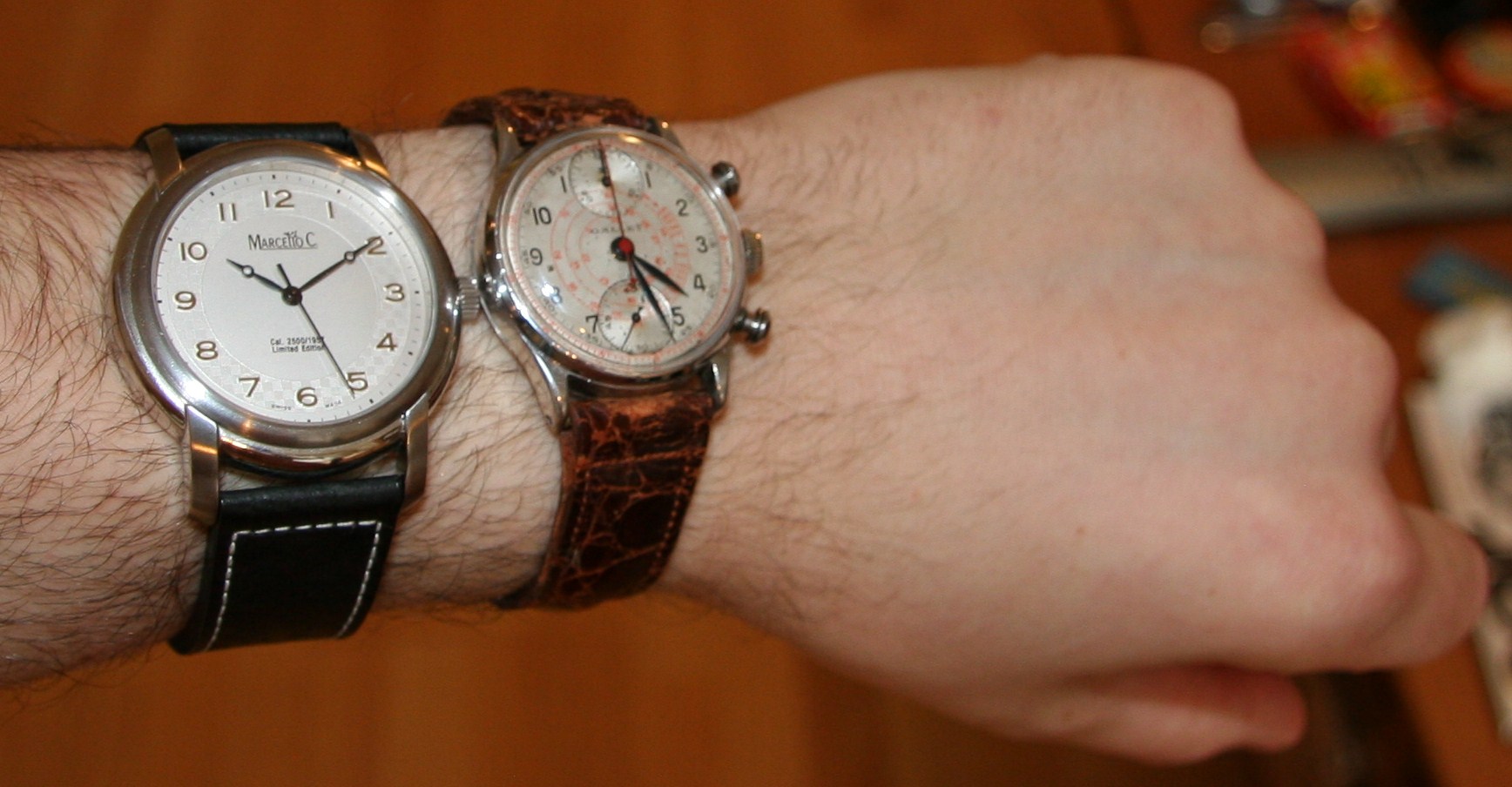
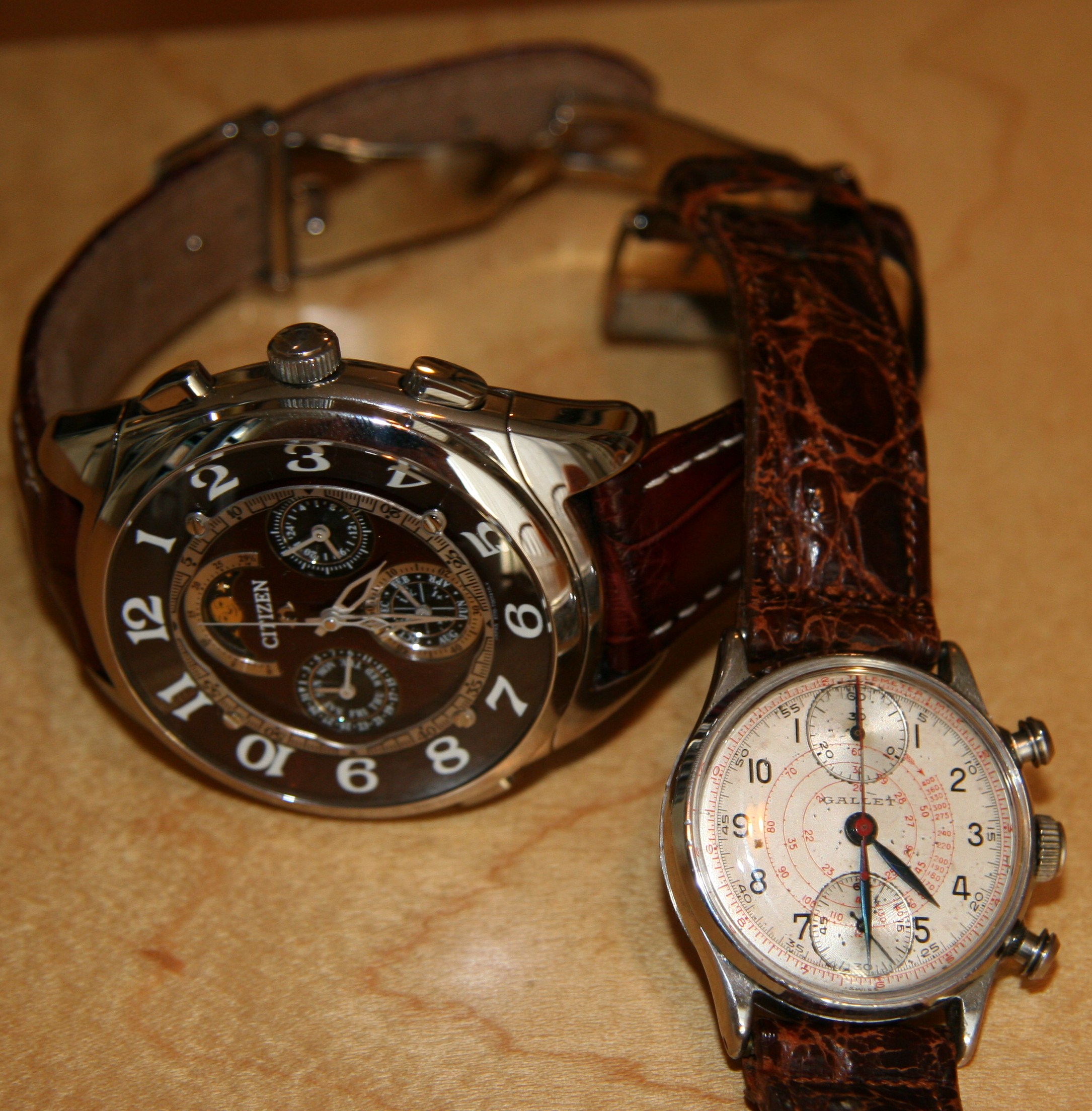
 My specimen for experimentation was a freshly restored Gallet. I don’t know much about the watch as it is exceedingly rare. But I can estimate that it was most likely manufactured in the early to mid 1940s (possibly 1930s). The watch was my grandfathers, and in pretty bad disrepair when I got it (no working, missing crystal, harsh oxidation). It’s working again now, and on my wrist. I will spare you the details of the restoration process, but due to a difficulty in finding parts, this restoration project far exceeded the the norm and took about a year of sitting around waiting for parts. My mostly original Gallet came back to me in an impressive, yet obviously vintage state. I stay away from the term antique, because that would imply obsolescence, and that is simply not the case here. One can buy a perfectly modern watch with a similar movement and functionality as this little Gallet.
My specimen for experimentation was a freshly restored Gallet. I don’t know much about the watch as it is exceedingly rare. But I can estimate that it was most likely manufactured in the early to mid 1940s (possibly 1930s). The watch was my grandfathers, and in pretty bad disrepair when I got it (no working, missing crystal, harsh oxidation). It’s working again now, and on my wrist. I will spare you the details of the restoration process, but due to a difficulty in finding parts, this restoration project far exceeded the the norm and took about a year of sitting around waiting for parts. My mostly original Gallet came back to me in an impressive, yet obviously vintage state. I stay away from the term antique, because that would imply obsolescence, and that is simply not the case here. One can buy a perfectly modern watch with a similar movement and functionality as this little Gallet.
Gallet is a Swiss brand that has been around for a while, probably near 100 years. They are currently trying to reinvigorate the brand. So don’t feel bad if you’ve never heard of them. This is probably the only place on the Internet you’ll see a picture of this particular watch. Gallet was big for a while selling aviation and military watches, so they have more of a functional rather than luxury heritage. Though in such times, a functional watch such as this was only reserved for those who could afford it as most people flying for pleasure were not of average means. Coincidentally, one of President Harry Truman’s watch was a Gallet Officer’s Chronograph that was similar to this watch, and likely manufactured in the same era. So this is a 30 minute chronograph with a subsidiary seconds dial in a bicompax orientation. The other subdial register is for the elapsed chronograph minutes. One of the rare traits about this Gallet is the vertical orientation of the subdials (as most are in a horizontal orientation). Other Gallet watches with similar looks and function have horizontally orientated subdials, and I have never see another one such as this model. The fact that the subdials are placed so close to the edges of the dial are an indication of the movement size. Compactness was a selling point, and the case in this watch is literally wrapped around the movement.
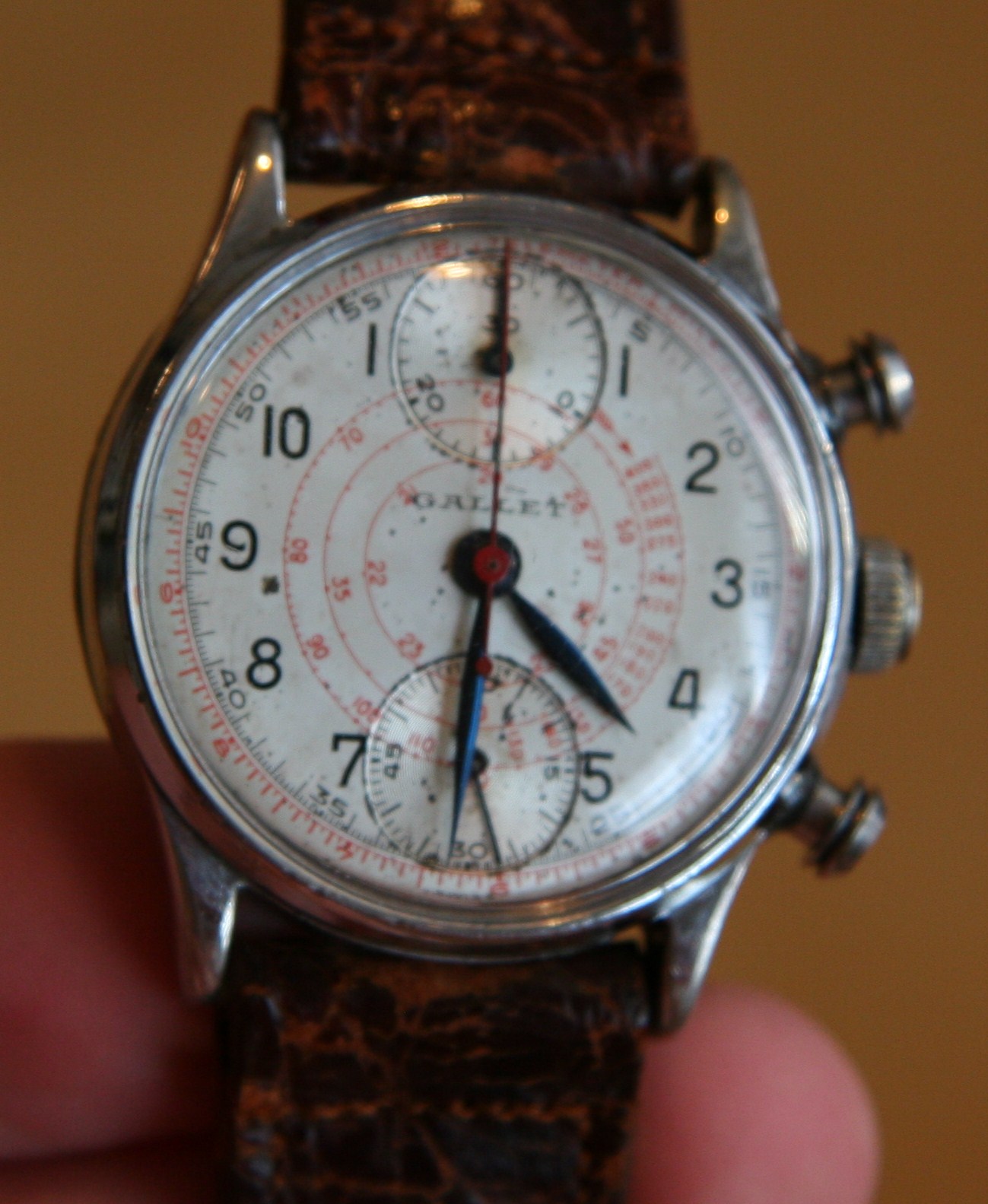 The first thing I noticed when I received this watch is how small it is in comparison to most watches in my collection. The Gallet is only 30mm wide without the crown, although it is about as thick as most other watches (mainly due to the tall crystal). 30mm is a woman’s size watch by today’s standards. A few of the images are of the Gallet in comparison to two other watches. One, is a manually wound 38mm wide German Marcello C watch, and the other is of a 45mm wide Citizen Campanola Grand Complication. You can see the drastic size differences, especially when worn on the wrist. Funny enough, the small size of this particular does not bother me much, even though I tend to stay away from small watches. It is one of the most legible watches I know own, and for what its worth, size doesn’t matter with this watch. So while I still feel as though the watch is petite, I am not too bothered by its minuscule stature (see how I have to keep justifying that to myself).
The first thing I noticed when I received this watch is how small it is in comparison to most watches in my collection. The Gallet is only 30mm wide without the crown, although it is about as thick as most other watches (mainly due to the tall crystal). 30mm is a woman’s size watch by today’s standards. A few of the images are of the Gallet in comparison to two other watches. One, is a manually wound 38mm wide German Marcello C watch, and the other is of a 45mm wide Citizen Campanola Grand Complication. You can see the drastic size differences, especially when worn on the wrist. Funny enough, the small size of this particular does not bother me much, even though I tend to stay away from small watches. It is one of the most legible watches I know own, and for what its worth, size doesn’t matter with this watch. So while I still feel as though the watch is petite, I am not too bothered by its minuscule stature (see how I have to keep justifying that to myself).
Despite the small size of the watch, you always seem to know it is there on your wrist. Quartz watch owners will never know about this, neither will most modern mechanical watch owners; but older mechanical watches ticked in an audible manner. Basically, the escapement releasing energy from the balance wheel creates a rapid ticking noise. On modern watches you really need to place your ear right up to a watch to hear it. However, before watch cases got thick, you could hear the faint ticking pretty well, even when your wrist is some distance from your head. To be honest, the noise is not at all unpleasant, and I am the type of personal easily annoyed by erratic noises. It is almost a friendly sort of reminder of what you are wearing. That there is a little operating machine on your wrist. It might not be something I want to hear everyday, but it is a charming novelty that I have come to sincerely appreciate.
Two main things keep this watch looking clear and legible for its size. And these two things are continually overlooked by other watch makers, which is a shame. The first is a very thin bezel size. The larger the dial of a watch is in comparison to the bezel, the larger the watch will appear to your eyes. Next, the watch hands are the right length. This is of the few watches that I own that has hands long enough! Seriously. The minute hand of any watch should extend almost all the way to the edge of the dial. The hour hand should stop right at where the hour markers stop. Not near, but exactly there. If you notice, there is a marked red perimeter at the edge of the dial, that the minute hand follows exactly. This actual ‘touching’ makes a closer mental association with the analog time in my opinion, and dramatically aids with legibility. I am going to coin a term for the opposite of well-sized hands, which I will call “polite hands.” Polite hands will now refer to watch hands that just aren’t long enough but are still functional. Polite hands are too shy to intrude into the domain of the markers, always staying a bit out of reach. Polite hands are far to common, and need to give way to more traditional, full length hands. There, I have finally said it. Now go to work ye watch makers of the world who ignore this necessity.
 So even though the Gallet dial is rather small, it makes the best use of space, which adds to its precision and functionality. Another aid of legibility is the contrast between the hands and the dial. A silvery finish on the dial contrasts with metallic blued hands. This allows the hands to really standout, making them easy to ready. Again, there is often not enough contrast between a watch dial and hands these days. This vintage Gallet excels at it meaning that watch designers these days who can’t figure out these simple points are either ill educated in how to make a watch functional and only care about form (about 90% of the time I think), or they are trying too hard to be ‘different.’
So even though the Gallet dial is rather small, it makes the best use of space, which adds to its precision and functionality. Another aid of legibility is the contrast between the hands and the dial. A silvery finish on the dial contrasts with metallic blued hands. This allows the hands to really standout, making them easy to ready. Again, there is often not enough contrast between a watch dial and hands these days. This vintage Gallet excels at it meaning that watch designers these days who can’t figure out these simple points are either ill educated in how to make a watch functional and only care about form (about 90% of the time I think), or they are trying too hard to be ‘different.’
The red colored chronograph seconds hand is aided by two units of measure. First is a graduated tachymeter scale which is used to measure speeds traveled given two, mile marker reference points. It is graduated in order to ensure that it fits in the dial (the spiraling you see). The scale is in light red as not to be a distraction unless you are using it. On the outermost perimeter of the watch is a telemeter scale, which is used to measure distances traveled if you know your speed. The chronograph pushers that you see on the watch are not the originals (which were damaged), these are really the only ones in the known universe that would fit without going to the great expense of the crafting custom made pushers. The originals where more classic piston-shaped pushers.
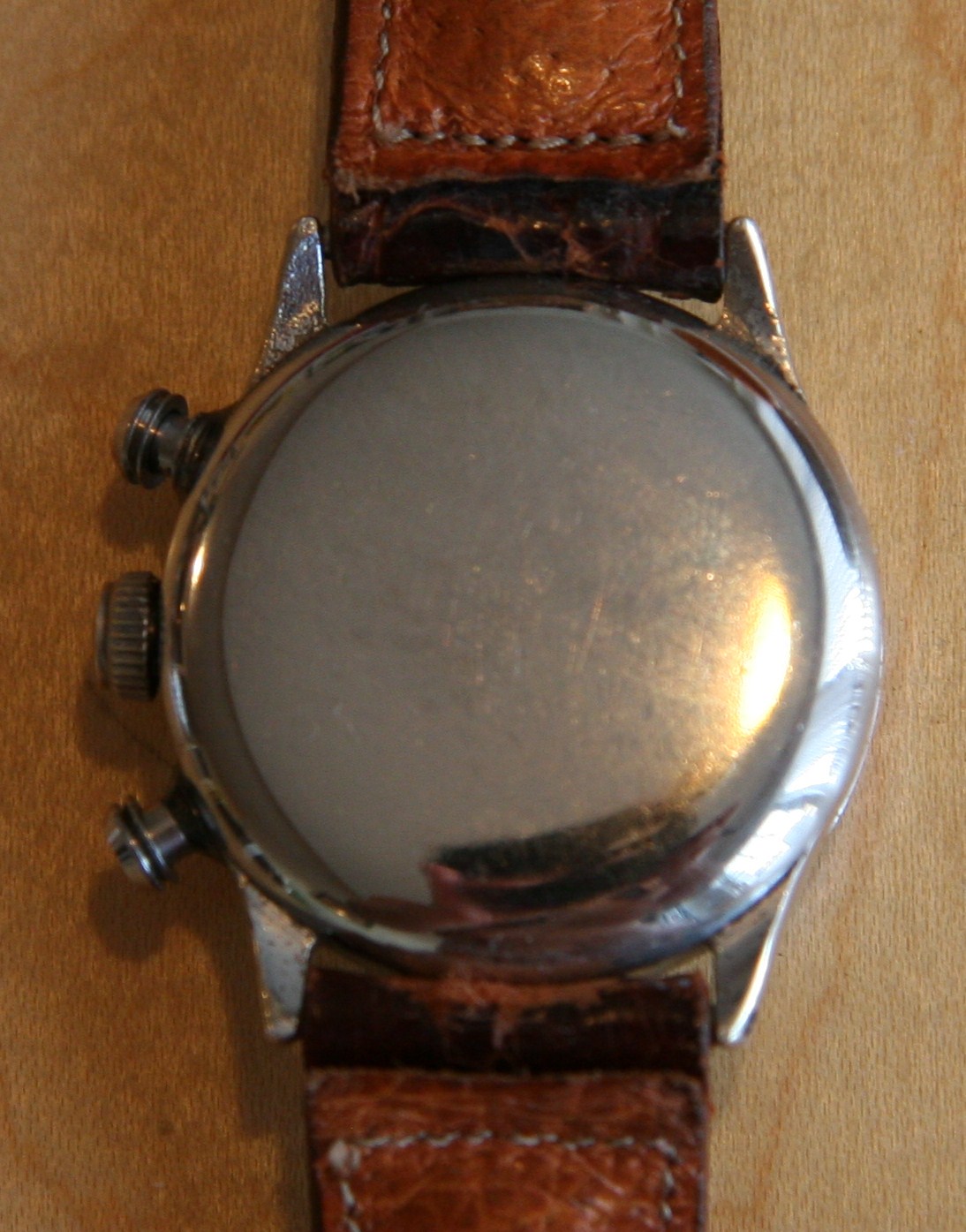 I don’t think the strap is original either, but it is pretty old. It is an alligator strap that shows typical wear from use, and then a generation spent in a desk. The strap has actually help up well. Close inspection of the case reveals a lot of wear as well, but also hints about its construction that involve a combination of hand application and machining. One thing you’ll notice about a lot of vintage watches is that the over ll construction of a watch does not match today’s standards. The movements are typically very well finished, but the cases are not up to today’s standards in terms of precise engineering and symmetry. Overall representing a higher level of deviance between individual units. Water resistance? Not really. The snap-on back and lack of gaskets in the crowns and pushers basically mean that you don’t want to get water near this (I was careful, really careful when I would need to wash my hands). We are used to modern watches offering at least a modicum of water protection, not here. So while this is not a delicate watch per se, I am concerned about its durability. Likewise, I am not sure the type of shock protection the movement has, if any. Meaning, I don’t feel comfortable doing just anything with this watch, as I would with more modern watches.
I don’t think the strap is original either, but it is pretty old. It is an alligator strap that shows typical wear from use, and then a generation spent in a desk. The strap has actually help up well. Close inspection of the case reveals a lot of wear as well, but also hints about its construction that involve a combination of hand application and machining. One thing you’ll notice about a lot of vintage watches is that the over ll construction of a watch does not match today’s standards. The movements are typically very well finished, but the cases are not up to today’s standards in terms of precise engineering and symmetry. Overall representing a higher level of deviance between individual units. Water resistance? Not really. The snap-on back and lack of gaskets in the crowns and pushers basically mean that you don’t want to get water near this (I was careful, really careful when I would need to wash my hands). We are used to modern watches offering at least a modicum of water protection, not here. So while this is not a delicate watch per se, I am concerned about its durability. Likewise, I am not sure the type of shock protection the movement has, if any. Meaning, I don’t feel comfortable doing just anything with this watch, as I would with more modern watches.
It is hard to think about who would have worn this type of Gallet in its hey day. Yes that rhymed. Any kind of man? How much did watch cost then, what about with inflation? I don’t have the answers to these questions. Sure we have hints, but overall it is mystery to me. It was not your average person’s watch. The brand was about as obscure then, as it is today. So I’d say a dedicated watch lover had to at least pick it out. Or someone shopping at the right watch boutique. This is all possible given the watch’s history. What I do know is that the watch is very handsome, the font for the hour markers is often copied today, and that similar watches in terms of style (IWC Portugueses) go for the many thousands. This particular Gallet is probably worth a couple of thousand dollars conservatively speaking, if you were curious.
The Gallet feels nice on my wrist and I like to wear it more than I thought I would. It is not a good everyday watch due to my feelings on its durability, but it doesn’t need to be. I have more than enough watches to wear a different one each day of the month. However, this Gallet is a special new addition to my collection. It is not only a piece of history, but a reminder of how consistent watch making has been over the years. What has changed are merely looks, materials, and size. And even then you can always find a brand new classic looking watch if you look in the right place. This watch is virtually as useful now, as it was when it was first sold, in its polished glory. One of the reasons that so many vintage watches exist, is the fact that their core functionality, the movement, is a hardy little machine that can last a long time.
[phpbay]gallet, num, “14324”, “”[/phpbay]